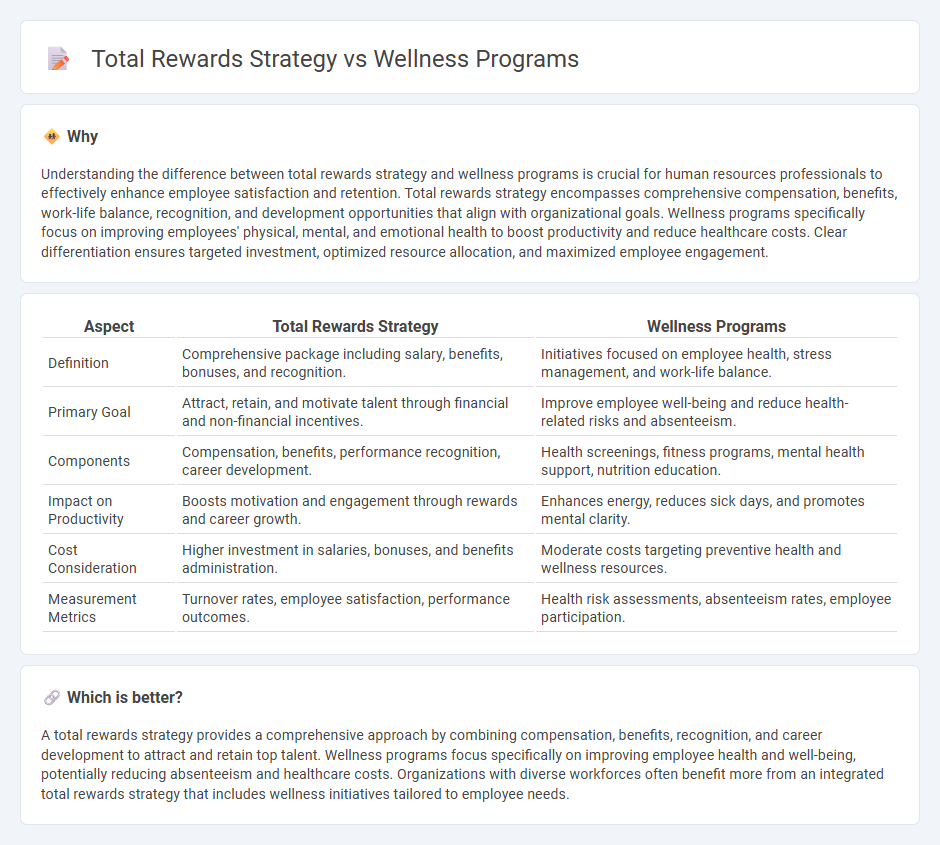
Total rewards strategy integrates compensation, benefits, recognition, and work-life balance initiatives to attract and retain top talent effectively. Wellness programs focus on improving employee health, reducing absenteeism, and enhancing productivity through preventive care and mental health support. Discover how blending these approaches can create a comprehensive human resources framework tailored to your organization's needs.
Why it is important
Understanding the difference between total rewards strategy and wellness programs is crucial for human resources professionals to effectively enhance employee satisfaction and retention. Total rewards strategy encompasses comprehensive compensation, benefits, work-life balance, recognition, and development opportunities that align with organizational goals. Wellness programs specifically focus on improving employees' physical, mental, and emotional health to boost productivity and reduce healthcare costs. Clear differentiation ensures targeted investment, optimized resource allocation, and maximized employee engagement.
Comparison Table
| Aspect | Total Rewards Strategy | Wellness Programs |
|---|---|---|
| Definition | Comprehensive package including salary, benefits, bonuses, and recognition. | Initiatives focused on employee health, stress management, and work-life balance. |
| Primary Goal | Attract, retain, and motivate talent through financial and non-financial incentives. | Improve employee well-being and reduce health-related risks and absenteeism. |
| Components | Compensation, benefits, performance recognition, career development. | Health screenings, fitness programs, mental health support, nutrition education. |
| Impact on Productivity | Boosts motivation and engagement through rewards and career growth. | Enhances energy, reduces sick days, and promotes mental clarity. |
| Cost Consideration | Higher investment in salaries, bonuses, and benefits administration. | Moderate costs targeting preventive health and wellness resources. |
| Measurement Metrics | Turnover rates, employee satisfaction, performance outcomes. | Health risk assessments, absenteeism rates, employee participation. |
Which is better?
A total rewards strategy provides a comprehensive approach by combining compensation, benefits, recognition, and career development to attract and retain top talent. Wellness programs focus specifically on improving employee health and well-being, potentially reducing absenteeism and healthcare costs. Organizations with diverse workforces often benefit more from an integrated total rewards strategy that includes wellness initiatives tailored to employee needs.
Connection
Total rewards strategy integrates compensation, benefits, and wellness programs to enhance employee engagement and retention. Wellness programs contribute to reducing healthcare costs and increasing productivity, aligning with the organization's overall rewards framework. This connection creates a holistic approach to employee well-being and motivation, driving organizational performance.
Key Terms
**Wellness Programs:**
Wellness programs prioritize employee health, mental well-being, and preventive care to enhance productivity and reduce healthcare costs. These initiatives often include fitness challenges, stress management workshops, and health screenings tailored to individual needs. Discover how integrating wellness programs into your total rewards strategy can create a healthier, more engaged workforce.
Health Promotion
Wellness programs prioritize health promotion through initiatives such as fitness challenges, nutritional counseling, and mental health support, directly enhancing employee well-being and productivity. Total rewards strategies integrate wellness programs with compensation, benefits, and recognition to create a comprehensive approach that motivates and retains talent. Explore how aligning wellness programs within total rewards can maximize organizational health and employee engagement.
Employee Assistance
Wellness programs within a total rewards strategy prioritize Employee Assistance by offering resources like counseling, stress management, and mental health support to enhance workforce well-being and productivity. Integrating these initiatives ensures comprehensive care that addresses both physical and emotional health, aligning with organizational goals to reduce absenteeism and improve engagement. Explore how combining wellness programs with total rewards strategies empowers employees and drives business success.
Source and External Links
Health and wellness programs - Mayo Clinic Health System - Mayo Clinic offers free, self-guided wellness programs, including journaling for gratitude, building healthy habits, and customizable monthly toolkits for individualized health journeys.
PEBB wellness programs | Washington State Health Care Authority - Washington State's PEBB provides voluntary wellness programs such as SmartHealth, diabetes management, and tobacco cessation, all covered by the medical plan and including potential wellness incentives.
Health & Wellness - Boys & Girls Clubs of America - Boys & Girls Clubs offer youth-focused wellness programs that include physical activity, nutrition education, and prevention programs like SMART Moves and SMART Girls to foster healthy behaviors and self-sufficiency.
 dowidth.com
dowidth.com